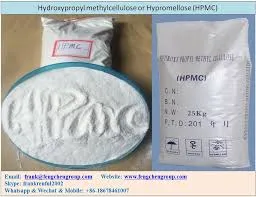
Dec . 05, 2024 05:44 Back to list
Exploring the Solubility of HPMC in Various Solvent Systems and Its Implications
Understanding HPMC Solubility A Key Factor in Pharmaceutical Formulations
Hydroxypropyl methylcellulose (HPMC) is a prominent polymer extensively used in pharmaceutical formulations, particularly in the development of various drug delivery systems. The solubility of HPMC plays a significant role in determining the performance, efficacy, and bioavailability of pharmaceutical products. This article explores the factors influencing HPMC solubility, its implications for drug formulations, and the methods to optimize HPMC use in pharmaceutical applications.
What is HPMC?
HPMC is a cellulose derivative that is modified to enhance its solubility and functional properties. It is classified as a non-ionic, water-soluble polymer, which makes it suitable for various applications, including tablet coatings, binders, and thickening agents. HPMC possesses amphiphilic characteristics, allowing it to interact with both hydrophilic and hydrophobic substances. This unique property makes HPMC an ideal excipient for numerous pharmaceutical formulations, catering to diverse solubility profiles of active pharmaceutical ingredients (APIs).
Factors Affecting HPMC Solubility
Several factors influence the solubility of HPMC in aqueous solutions
1. Molecular Weight The molecular weight of HPMC significantly affects its solubility. Generally, HPMC with a lower molecular weight exhibits higher solubility in water. Higher molecular weight HPMC tends to form viscous solutions, which may hinder solubility. Therefore, selecting the appropriate molecular weight is crucial for achieving the desired solubility profile in formulations.
2. Hydroxypropyl and Methyl Substitutions The degree of substitution and the ratio of hydroxypropyl to methyl groups in HPMC affect solubility and viscosity. Higher levels of hydroxypropyl substitution enhance water solubility, while methyl substitution impacts the polymer's viscosity. The balance between these substitutions can be optimized based on the specific requirements of the formulation.
3. Temperature Temperature plays a crucial role in the solubility of HPMC. Generally, increasing the temperature improves the solubility of polymers in aqueous solutions due to increased molecular mobility. However, the extent of this effect may vary depending on the specific formulation and the characteristics of the other components present.
4. pH of the Solution The pH of the solution can also impact the solubility of HPMC. Although it is primarily water-soluble, certain pH levels can influence the ionization of functional groups within HPMC, affecting its interaction with other excipients and APIs. This is particularly relevant in formulations designed for specific release profiles.
hpmc solubility

5. Ionic Strength The presence of salts or electrolytes in the solution can alter the solubility and viscosity of HPMC. Ionic strength affects polymer chain conformation and hydration, leading to changes in solubility. It is essential to consider the ionic environment when formulating with HPMC.
Implications for Drug Formulations
The solubility of HPMC is crucial for its efficacy in drug formulations. HPMC's viscosity and gel-forming properties can influence the release rates of APIs from various dosage forms, such as tablets, gels, and films. In controlled-release formulations, for instance, the solubility of HPMC dictates the drug release profile, which is critical for ensuring therapeutic effectiveness while minimizing side effects.
Furthermore, the use of HPMC in formulations aimed at improving the solubility of poorly soluble drugs is gaining attention. By incorporating HPMC, formulators can enhance the wettability and dispersibility of solid dosage forms, leading to improved dissolution rates and bioavailability of hydrophobic APIs.
Optimizing HPMC Use
To optimize the use of HPMC in pharmaceutical formulations, one must consider
- Selection of Molecular Weight Choose the appropriate molecular weight based on the desired viscosity and solubility requirements. - Balancing Substitution Ratios Tailor the hydroxypropyl and methyl substitution ratios to achieve optimal solubility and viscosity for a specific formulation. - Conducting Compatibility Studies Perform comprehensive studies to assess the compatibility of HPMC with other excipients and APIs to ensure stability and efficacy in the final product. - Utilizing Advanced Techniques Consider employing advanced techniques, such as hot-melt extrusion or spray drying, to enhance the solubility of HPMC and the overall formulation.
Conclusion
Understanding HPMC solubility is vital for pharmaceutical scientists and formulators striving to enhance drug delivery systems. By considering the various factors that influence HPMC solubility, effective formulations can be developed, thus improving the therapeutic outcomes of pharmaceutical products. The continued study and optimization of HPMC will play a pivotal role in the advancement of drug formulation strategies.
-
Versatile Hpmc Uses in Different Industries
NewsJun.19,2025
-
Redispersible Powder's Role in Enhancing Durability of Construction Products
NewsJun.19,2025
-
Hydroxyethyl Cellulose Applications Driving Green Industrial Processes
NewsJun.19,2025
-
Exploring Different Redispersible Polymer Powder
NewsJun.19,2025
-
Choosing the Right Mortar Bonding Agent
NewsJun.19,2025
-
Applications and Significance of China Hpmc in Modern Industries
NewsJun.19,2025







